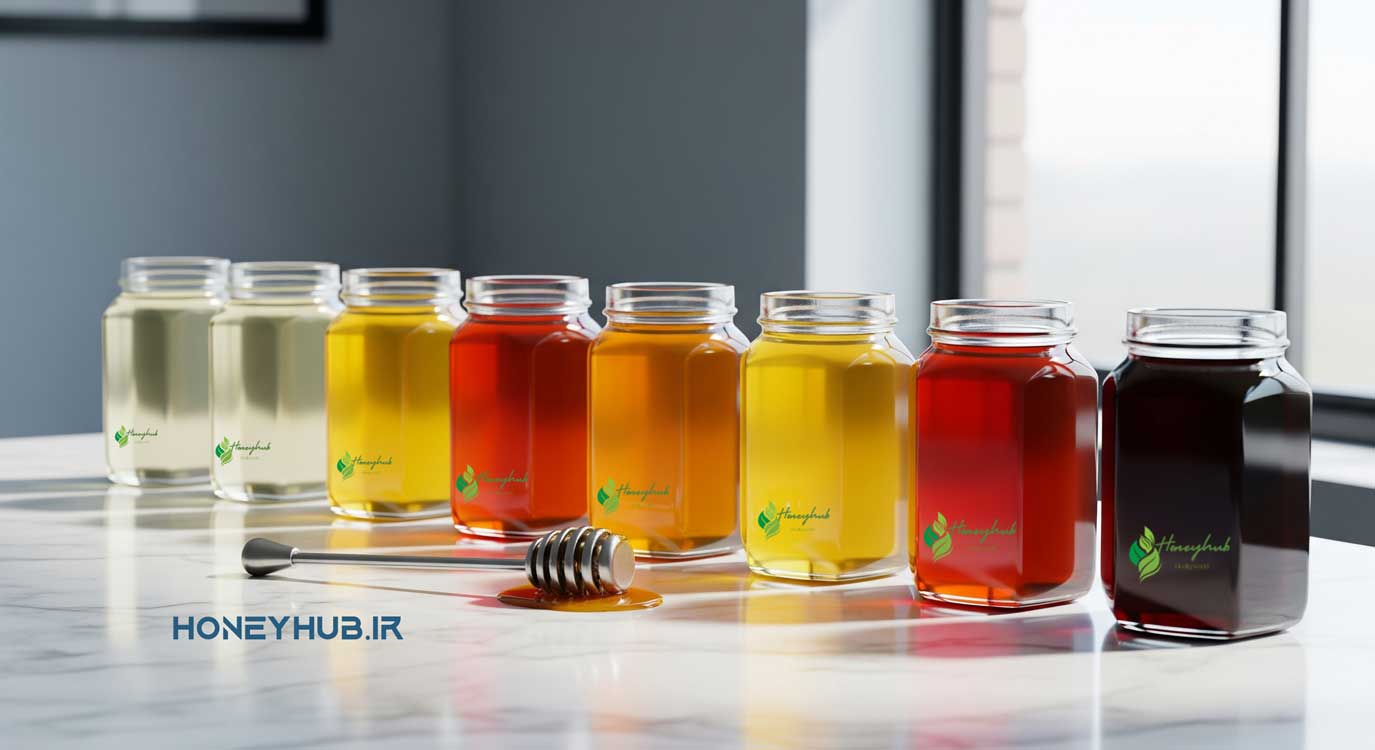Does your mozzarella refuse to stretch or just burn? The secret is science. From "pasta filata" to the crucial role...
What Does the Color of Honey Reveal? A Journey from Clarity to Darkness
When you hold a jar of honey, the first thing that catches your attention is its color. From watery white and golden yellow to warm amber and dark brown, a world of variety unfolds before your eyes. But have you ever wondered what these differences in honey color mean? The color of this liquid gold, beyond being just an outward feature, serves as a precise identity of the bee's journey, the plant source, mineral compositions, and even its medicinal properties. In this comprehensive article, we delve into the secrets hidden in honey's color and learn how to read its story just by looking at a jar of honey.
What Are the Main Factors Determining Honey Color?
The color of a specific honey is the result of a complex interaction of several natural and processing factors. Contrary to popular belief that links color solely to the type of flower, many factors contribute to this color palette. Understanding these factors helps us make a more scientific and precise choice when selecting and consuming honey.
1. Plant Origin (Flower Nectar): The Most Important Factor
The most significant and primary factor determining honey color is the flower nectar that the bee feeds on. Each plant contains unique chemical compounds in its nectar. Natural pigments like carotenoids, flavonoids, and anthocyanins in the nectar are directly transferred to the honey, defining its color spectrum.
- Light-colored honey (from white to light yellow): Typically comes from plants like acacia, clover, broom, and cotton. For example, acacia honey is renowned globally for its clarity and very light color. These honeys often have a mild, floral taste.
- Medium-colored honey (from golden to amber): This category, which includes a large portion of honeys, comes from plants like thyme, citrus, sidr (jujube), and alfalfa. Thyme honey, with its amber color and strong flavor, is a prime example of this category.
- Dark honey (from dark brown to black): These honeys come from plants like buckwheat, chestnut, and some forest trees (honeydew). Buckwheat honey is one of the darkest honeys in the world and has a very strong, unique flavor.

The diversity in honey colors reflects the diversity of the region's vegetation.
2. Amount and Type of Minerals
There is a general scientific rule: the darker the honey, the more minerals it typically contains. Elements like potassium, manganese, iron, copper, and sodium influence honey's color. Nectar derived from plants grown in mineral-rich soils produces darker honey, rich in these compounds. This is why dark honeys like buckwheat honey are considered good sources of iron and antioxidants.
3. Honey Age and Storage Conditions
Honey is a living and dynamic substance, and over time it undergoes chemical changes. One of these changes is the darkening of its color. This phenomenon occurs due to the Maillard reaction and the caramelization of sugars in honey through slow oxidation. Factors like exposure to direct sunlight and high temperatures accelerate this process. Therefore, freshly harvested honey may have a lighter color than the same honey after a year of storage. Keeping honey in a cool, dark place helps preserve its color and initial quality.
Complete table of honey colors and characteristics
In the table below, you can observe the amazing variety of natural honey colors and their characteristics:
| Honey Name | Color | Taste | Medicinal Properties | Suitable for |
|---|---|---|---|---|
| Saffron | Saffron orange | Mild with a strong fragrance | Boosts immune system, anti-depressant | Direct consumption, special desserts |
| Toranjin (Gorse) | Dark brown | Strong and earthy | Treats urinary infections, kidney stones | Therapeutic use, tea |
| Thyme | Red-brown | Spicy and fragrant | Anti-cough, respiratory infection treatment | Cold treatment, herbal medicine sweetener |
| Clover | Colorless and light | Mild and sweet | Quick energy boost, child strengthening | Daily consumption, sweetening beverages |
| Sumac | Light yellowish | Floral and mild | Relaxant, stress reduction | Before sleep, stress relief |
| Chestnut | Dark brown | Malty and rich | Rich in iron, anti-anemia | Consumption with breakfast, mixing with nuts |
| Sage | Dark amber | Bitter taste | Memory booster, anti-Alzheimer’s | Morning consumption |
| Acacia | Colorless, watery | Very mild | Suitable for diabetics (with doctor's advice) | Sweetening tea, food applications |
| Sunflower | Golden yellow | Sweet and fruity | Instant energy source | Athletes, intense physical activities |
| Broom | Pale yellow | Mild with a floral aftertaste | Immune system booster, anti-cancer | Daily use, disease prevention |
| Sidr | Light brown | Sweet, caramel-like | Sexual tonic, energy booster | Mix with warm milk, energy potions |
| Coriander | Medium brown | Aromatic and slightly spicy | Reduces cholesterol, improves digestion | After meals, digestive issues |
| Set honey | White | Creamy and mild | Natural probiotic, digestion improvement | On toast, mixing with cheese |
| Citrus | Light yellow | Sour and sweet | Vitamin C source, cold prevention | Cold season, immune system boost |
| Forty herbs | Light brown | Complex and multi-dimensional | Combination of various properties | General consumption, sugar substitute |
| Spring | Light yellow | Mild and floral | Energy boosting, anti-fatigue | Daily use, all-purpose |
| Oregano | Yellow-green | Spicy and fragrant | Strong antimicrobial, anti-infection | Cold treatment, infections |
| Pomegranate | Amber with a red tint | Sour and sweet | Reduces blood pressure, blood purification | High blood pressure patients |
| Thyme | Dark golden yellow | Fragrant and slightly spicy | Anti-bloating, digestion improvement | After meals, digestive issues |
| Gum | Light amber | Fruity and mild | Anti-cough, throat softener | Sore throat, dry cough |
4. Processing and Human Intervention
Processing methods can also change honey's color. Heating honey (pasteurization), which is done to prevent crystallization and eliminate yeasts, can darken its color. On the other hand, intense filtration to remove pollen and wax particles may make the honey appear lighter and clearer. This is why raw honey (unheated and unfiltered) generally has a cloudier color due to the suspended particles of pollen and wax.
Overall, honey color depends on various factors, the most important of which are:
Chemical Composition of Flower Nectar
Each plant has its unique nectar composition, which includes natural pigments like carotenoids, flavonoids, and anthocyanins. These compounds not only determine the color but also many of honey’s medicinal properties.
Minerals in Nectar
The concentration of minerals like iron, copper, and manganese in flower nectar has a direct impact on the final honey color. Typically, honeys with more minerals tend to be darker in color.
Natural Chemical Reactions
Over time, honey undergoes chemical reactions like the Maillard reaction, which causes it to darken. This process is natural and is not a sign of spoilage.
Honey Color and Quality/Medicinal Properties
| Characteristic | Light Honey | Dark Honey |
|---|---|---|
| Antioxidants | Lower (typically 20-50 mg/kg) | Higher (up to 200 mg/kg in some varieties) |
| Minerals | Lower concentration | Rich in iron, magnesium, zinc |
| Glycemic Index | Higher (60-70) | Lower (50-60) |
| Phenolic Compounds | Lower diversity | Higher diversity |
| Fructose Content | Higher (crystallizes slower) | Lower (crystallizes faster) |
Specific Benefits of Each Color Range:
- Light Honeys: Quick energy boost, suitable for children, gentle on the stomach
- Yellow to Amber Honeys: A good balance of taste and medicinal properties
- Brown Honeys: Rich in minerals, suitable for anemia
- Red to Green Honeys: Strong antimicrobial properties, suitable for infections
Pfund Scale: The Global Standard for Honey Color Measurement
To standardize honey color evaluation scientifically, a tool called the Pfund Color Grader is used. This system compares the honey’s color with a set of standardized colored glasses and assigns a number in millimeters (mm). The higher the number, the darker the honey. The U.S. Department of Agriculture (USDA) has provided the following categorization based on the Pfund scale:
| Color Category | Pfund Scale Range (mm) | Plant Source Example |
|---|---|---|
| Water White | 0 - 8 | Acacia, sweet clover |
| Extra White | 9 - 17 | Broom, certain types of cotton |
| White | 18 - 34 | Clover, citrus |
| Extra Light Amber | 35 - 50 | Alfalfa, sunflower |
| Light Amber | 51 - 85 | Thyme, sidr (jujube) |
| Amber | 86 - 114 | Forest honeydew, some multi-floral honeys |
| Dark Amber | More than 114 | Buckwheat, chestnut, avocado |
How to Choose Honey Based on Color
For Daily Use
Light to yellow honeys (clover, acacia, citrus) that have a milder flavor and are ideal for sweetening tea and food.
For Medicinal Properties
Darker honeys (gorse, thyme, chestnut) that are richer in antioxidants and minerals.
For Specific Uses
Honeys with unusual colors (oregano, pomegranate) that have unique properties.
Honey Color, Flavor, and Antioxidant Properties
Now that we are familiar with the factors influencing color, we reach the exciting part of the story: what does honey color tell us about its flavor and health benefits?
In terms of taste and aroma: There is a direct relationship between color and flavor intensity.
- Light Honeys: They typically have a mild, sweet taste, often with floral or fruity notes. These honeys are ideal for those who prefer subtle flavors or wish to use honey as a sweetener without overpowering the main taste of the food or drink (for example, in green tea).
- Dark Honeys: They have a much stronger, more complex, and lingering flavor. Caramel, malt, spicy, and even slightly bitter notes can be sensed in these honeys. These are perfect for medicinal use or for those seeking a powerful tasting experience.
In terms of antioxidant properties: This is where science comes to our aid. Numerous studies have shown a strong correlation between the darkness of honey and the level of antioxidant compounds it contains. Dark honeys are rich in phenolic compounds and flavonoids, which act as strong antioxidants. These compounds help neutralize free radicals in the body, reduce oxidative stress, and prevent chronic diseases such as heart disease and some cancers. A study published in the prestigious journal Molecules clearly shows that the antioxidant capacity of honey significantly increases as its color darkens.
Common Myths About Honey Color
There is a lot of misinformation about honey color that we should set aside:
- Myth 1: Dark honey is always better than light honey.
Reality: "Better" depends on your goal. If you’re looking for maximum antioxidant properties, dark honey is the better choice. However, if you prefer a milder taste or want the specific benefits of a light honey like acacia honey, your choice will be different. Every honey, regardless of color, has its unique properties. - Myth 2: Light color indicates purity, and dark color indicates adulteration.
Reality: This belief is completely wrong. As we have seen, dark color can indicate a specific plant origin or high mineral content. On the other hand, adulterated honey (made from glucose syrup) can be produced in any color. Color alone is never a reliable criterion for distinguishing pure honey from adulterated honey. To do so, you need to consider other factors like aroma, taste, viscosity, and laboratory tests. For more information, you can read our article on [Types of Natural Honey and How to Identify Them] on our website. - Myth 3: Dark honeys never crystallize.
Reality: All natural honeys, due to their high glucose and fructose content, have the potential to crystallize. The speed of this process depends on the ratio of these two sugars. Some dark honeys may crystallize slower, but this is not a general rule. Crystallization is a natural process and a sign of honey’s purity, not its spoilage.
Conclusion: The Color of Honey, A Story of Nature
Ultimately, the color of honey is not just a simple and superficial feature, but a fascinating window into its world. Each drop of honey holds the story of a specific flower, a unique geographical area, and an adventurous journey from the hive to the jar. By understanding how plant origin, mineral content, time, and processing influence this color palette, we can make more informed choices when selecting honey. Whether you're after the mild, floral taste of a light honey or the strong antioxidant properties of a dark one, you now know that every color hides valuable secrets and treasures. So, the next time you hold a jar of honey, take a moment to gaze at its color and listen to the story it tells.














Leave a comment